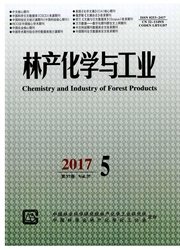

 中文摘要:
中文摘要:
分别采用超声波与碱润胀对微晶纤维素进行活化,比较了两种方法对微晶纤维素(MCC)超分子结构和物理特性的影响,并通过与高碘酸钠的反应分析了不同活化方法对微晶纤维素选择性氧化性能的影响,初步探讨了其作用机理。结果表明,超声波作用后微晶纤维素的晶型没有发生改变。晶粒尺寸基本不变,但是超声波能使纤维素分子中的氢键受到破坏,结晶度下降,结构变得疏松,表面和内部结构受到一定的损伤,比表面积和可及度增大,反应活性提高;碱润胀后,微晶纤维素的晶型发生了改变,为纤维素Ⅰ型和Ⅱ型的混合体,但碱润胀有消晶的作用,使晶区发生破裂,晶粒尺寸大幅度下降,比表面积显著增加。两种活化方法都能显著提高纤维素的选择性氧化性能,超声波和碱润胀活化后氧化纤维素(DAC)的醛基含量分别由未活化时的71.3%提高到85.0%和88.8%。
 英文摘要:
英文摘要:
Ultrasound treatment and alkali swelling were applied to activate microcrystalline cellulose (MCC) in order to improve its reactivity performance. Changes in supramolecular structure and physical characteristics among MCC after activation were compared, The influences of ultrasound treatment and alkali swelling on oxidation reactivity of MCC were investigated in the presence of sodium periodate. The mechanism of the change of reactivity after activation was discussed. The results showed that the type of MCC crystal was not changed and the size of crystalline was almost not changed after ultrasound treatment. However, after ultrasound treatment crystallinity of MCC was decreased and hydrogen bonds among MCC molecules were destroyed. MCC particles were broken into small particles and the surface was damaged. These changes are attributed to the increases of accessibility and specific surface area of MCC with an improvement on reactivity. The type of MCC crystal after alkali swelling was changed to the mixture of types Ⅰ and Ⅱ. The size of MCC crystal was decreased while specific surface area was increased remarkably through decrystallization by alkali swelling. Furthermore, aldehyde content of dialdehyde cellulose (DAC) was improved from 71.3 % to 85.0 % and 88.8 % respectively by activation of ultrasound treatment and alkali swelling, indicating an improvement of regioselective oxidation reactivity of MCC in the presence of sodium periodate.
 同期刊论文项目
同期刊论文项目
 同项目期刊论文
同项目期刊论文
 期刊信息
期刊信息
